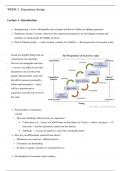Tentamen (uitwerkingen)
CS3001 - Advanced Topic in Computer Science - Microservices
- Vak
- Instelling
This pdf contains Exam revision for the topic Microservices. This also includes lab questions and answer that also comes up in the exam. I got A+ from this revising from these notes/ exam questions and answer.
[Meer zien]




